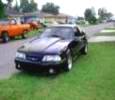I am looking for a good technical explanation of why I should use blower pistons in my next shortblock and what will I gain in power going from 9.5:1 down to around 8:1? Boost will be in the neighborhood 11 or 12 PSI.
I figure if I put my new crank pulley on now with my current compression I will have to use race gas and or no timing.
Any thoughts would be appreciated.






 Reply With Quote
Reply With Quote












Bookmarks